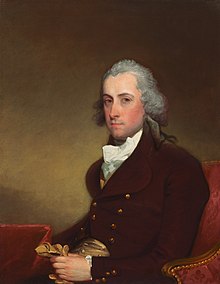
Back ستيفن فان رينسيلار Arabic ستيفن فان رينسيلار ARZ ایستفن وان رنزسلار AZB Stephen Van Rensselaer III. German Stephen Van Rensselaer Finnish Stephen Van Rensselaer French Stephen Van Rensselaer III Dutch Stephen Van Rensselaer NB Stephen van Rensselaer Swedish
Stephen Van Rensselaer | |
|---|---|
 Stephen Van Rensselaer III, c. 1790s, by Gilbert Stuart | |
| Member of the U.S. House of Representatives from New York | |
| In office March 12, 1822 – March 3, 1829 | |
| Preceded by | Solomon Van Rensselaer |
| Succeeded by | Ambrose Spencer |
| Constituency | 9th district (1822–1823) 10th district (1823–1829) |
| Lieutenant Governor of New York | |
| In office 1795–1801 | |
| Governor | John Jay |
| Preceded by | Pierre Van Cortlandt |
| Succeeded by | Jeremiah Van Rensselaer |
| Member of the New York State Senate from the Western District, at-large | |
| In office 1791–1796 | |
| Member of the New York State Assembly from the Albany County District, at-large | |
| In office 1789–1791 | |
| Grand Master of the Masonic Grand Lodge of New York | |
| In office 1825–1829 | |
| Preceded by | Joseph Enos |
| Succeeded by | Morgan Lewis |
| 9th Patroon and 6th Lord of the Manor of Rensselaerswyck | |
| In office 1769–1839 | |
| Preceded by | Stephen Van Rensselaer II |
| Succeeded by | Stephen Van Rensselaer IV |
| Personal details | |
| Born | November 1, 1764 New York City, Province of New York, British America |
| Died | January 26, 1839 (aged 74) New York City, U.S. |
| Resting place | Albany Rural Cemetery, Menands, New York |
| Political party | Federalist Adams Republican |
| Spouses | |
| Children | 12, including Stephen, Cortlandt and Henry |
| Relatives | See Van Rensselaer family |
| Alma mater | Harvard College |
| Profession | Landowner Businessman |
| Net worth | USD $10 million at the time of his death (equivalent to between $282 million and $349 million in 2023.)[1][2][3] |
| Signature | |
Stephen Van Rensselaer III (/ˈrɛnslər, -slɪər/;[4] November 1, 1764 – January 26, 1839) was an American landowner, businessman, militia officer, and politician. A graduate of Harvard College, at age 21, Van Rensselaer took control of Rensselaerswyck, his family's manor. He developed the land by encouraging tenants to settle it and granting them perpetual leases at moderate rates, which enabled the tenants to use more of their capital to make their farms and businesses productive.
Active in politics as a Federalist, Van Rensselaer served in the New York State Assembly and New York State Senate, and as the lieutenant governor of New York. After the demise of the Federalist Party, Van Rensselaer was a John Quincy Adams supporter and served in the United States House of Representatives for one partial term and three full ones. Van Rensselaer was a supporter of higher education; he served on the board of trustees for several schools and colleges and was the founder of the Rensselaer Polytechnic Institute. He was also a civic activist and philanthropist and was a founder of Albany's public library and the city's Institute of History & Arts.
Long active in the militia, Van Rensselaer attained the rank of major general; he commanded troops on the New York-Canada border during the War of 1812, but resigned his commission after defeat at the Battle of Queenston Heights. After Van Rensselaer's 1839 death, efforts by his sons to collect past due lease payments led to the Anti-Rent War, and the break up and sale of the manor. As the heir to and then owner of one of the largest estates in New York, Van Rensselaer's holdings made him the tenth richest American of all time, based on the ratio of his fortune to contemporary GDP.
- ^ "The Last Patroon". newnetherlandinstitute.org. New Netherland Institute. Retrieved November 6, 2023.
With assets at his death worth approximately $10,000,000, or 1/65 of the nation's Gross Domestic Product, Fortune magazine listed Stephen III as the tenth richest American of all-time.
- ^ Friedman, Morgan (October 16, 2023). "The Inflation Calculator". The Inflation Calculator. Westegg.com. Retrieved November 6, 2023.
- ^ Webster, Ian. "CPI Inflation Calculator". Official Data.org. Official Data Foundation. Retrieved November 6, 2023.
- ^ Thomas, Dave (September 28, 2011). "RENSSELAERVILLE (Documentary Film)". YouTube. Retrieved May 11, 2020.
© MMXXIII Rich X Search. We shall prevail. All rights reserved. Rich X Search